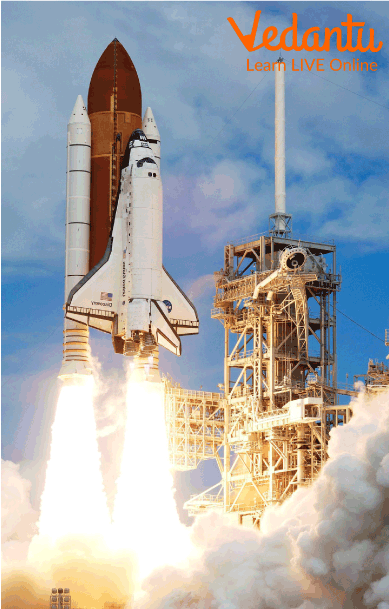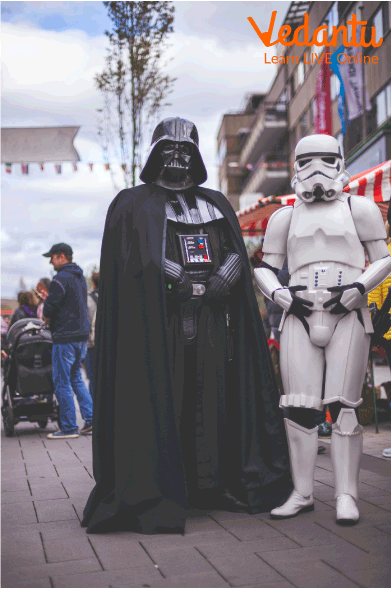




What is Spacecraft?
A spacecraft is a vehicle capable of transporting people and cargo beyond the Earth's atmosphere, through space to other planetary bodies, space stations, or orbits, and back. Launch vehicles are spacecraft that are launched from the surface of a planet and typically take off from launch pads at spaceports. Numerous other manned and unmanned craft have been launched to advance scientific knowledge, enhance national security, or provide critical services such as telecommunications and weather forecasting.

Spacecraft
Types of Spacecraft
Have you ever wondered how many types of spacecraft there are? There are various types of spacecraft according to their design and purpose. In general, they are of three types:
Crewed Spacecraft: Crewed spacecraft are designed to support human life during the mission's human spaceflight portion. Human spacecraft must be fit for purpose and have a human-rating certification. The first crewed spacecraft was Vostok 1 and currently, there are two space stations in orbit around the earth, i.e., the international space station and the Chinese Tiangong space station. Space capsules, spaceplanes, and space stations.
Earth Orbit Satellites: The satellites which orbit around the earth are known as earth orbit satellites. After leaving the satellite in space, it should be properly placed in the corresponding orbit. It revolves in a specific way and serves a purpose, whether scientific, military, or commercial. Earth Orbits are the orbits assigned to satellites with respect to the Earth. Earth Orbit Satellites are satellites that are present in those orbits. Types of earth orbit satellites are:
Geosynchronous Earth Orbit Satellite
Medium Earth Orbit Satellites
Low Earth Orbit Satellites.
Types of Propulsion System in Spacecraft
Any method used to accelerate spacecraft and artificial satellites is referred to as spacecraft propulsion. In-space propulsion is the use of propulsion systems in the vacuum of space and should not be confused with space launch or atmospheric entry. The types of spacecraft propulsions are generally divided into four groups on the basis of physics:
Chemical Propulsion
Electric Propulsion
Advanced Propulsion Technologies
Supporting Technologies
Star Wars
Star Wars is a George Lucas-created American epic space opera multimedia franchise that began with the eponymous 1977 film and quickly became a worldwide pop-culture phenomenon. The franchise has spawned numerous films and other forms of media, including television series, video games, novels, comic books, theme park attractions, and themed areas, resulting in an all-encompassing fictional universe.

Star Wars
Types of Spacecraft in Star Wars
TIE Fighter: Throughout the majority of the Galactic Civil War and beyond, the TIE was the standard Imperial starfighter. With a maximum atmospheric speed of 1200 kph, it was the fastest in the galaxy. It may require up to two pilots. It is of 6m in length.
X-Wing: The T-65 X-Wing has an almost perfect balance of speed, manoeuvrability, and defensive shielding, making it the Rebel Alliance's fighter of choice. It is not as fast as a TIE fighter, but it has more autonomy (up to a week) and can carry more cargo. One pilot and one astromech droid make up the crew. It is 12m in length.
Millennium Falcon: The Millennium Falcon was a light freighter that Han Solo and Chewbacca used as smugglers. The ship's aged appearance belied numerous advanced modifications to improve its speed, weapons, and shield. It can carry up to six passengers and has a cargo capacity of 100 metric tonnes. It is of 34m in length.
Destroyer: These ships are extremely effective, not only because of their firepower but also because of their sheer size. It carries 72 TIE fighters and numerous ground forces, including stormtroopers, and is armed with turbolasers, ion cannons, and tractor beam projectors. It is of 1600m in length.
Droid Control Ship: Battle droid armies on planetary surfaces were coordinated using Droid Control Ships. The ship resembled a standard Lucrehulk-class battleship in appearance, with 1,500 Vulture droid starfighters ready to fight the enemy. Anakin Skywalker annihilated a Droid Control Ship, ensuring Naboo's victory. It is 3170m in length.
Executor: The Executioner subclass Lord Darth Vader's personal flagship, the Star Dreadnought Executor, was one of the largest and most powerful Imperial vessels ever built. With over 5,000 turbolasers and ion cannons, it could wipe out a portion of the planet in a matter of hours. It could transport up to 50,000 ground troops. It is 19000m in length.
Death Star: The Galactic Empire built the Death Star, a moon-sized deep space mobile battle station. It possessed a super laser weapon capable of annihilating an entire planet. The DS1 was crewed by 265,675 people, including 52,276 gunners, 607,360 troops, 30,984 stormtroopers, 42,782 ship support personnel, and 180,216 pilots and workers. It is 160km in length.
Solved Questions
1. What is a spacecraft?
Ans: A spacecraft is a vehicle capable of transporting people and cargo beyond the Earth's atmosphere, through space to other planetary bodies, space stations, or orbits, and back.
2. How many types of earth orbit satellites are there?
Ans: There are three types of earth orbit satellites.
3. Who launches the first spacecraft?
Ans: The Soviet Union launched the first spacecraft.
Learning by Doing
Write True Or False.
Sputnik 1 was the first launched spacecraft_________
Star Wars is a George Lucas-created American epic space opera________
The first reusable spacecraft was the space shuttle________
Summary
Spacecraft is a vehicle designed to travel in space outside the earth’s atmosphere. The first reusable spacecraft was the space shuttle. Humans have learned a great deal about the planets, stars, and other objects in space thanks to space exploration. Since 1957, over 5,000 spacecraft have been launched into orbit to collect data. They include human-powered spacecraft, space probes, and satellites. Initially, the Soviet Union (now Russia) and the United States were the primary countries involved in space exploration. Many other countries are now taking part.
FAQs on Types of Spacecrafts
1. What are the main types of spacecraft?
Spacecraft are broadly categorised based on their mission and whether they carry humans. The main types include:
- Crewed Spacecraft: These are designed to support human life in space for missions like travelling to the International Space Station (ISS) or, in the past, to the Moon. Examples include the Soyuz and Crew Dragon.
- Satellites: These are objects placed in orbit around the Earth or another celestial body. They are used for communication, weather forecasting, navigation (GPS), and scientific observation.
- Space Probes: These are robotic spacecraft that travel through space to explore distant planets, moons, asteroids, or comets. They do not orbit Earth and are designed for deep space exploration. Examples include the Voyager probes.
- Rovers and Landers: These are designed to land on the surface of another celestial body. Landers remain stationary to conduct experiments, while rovers can move around to explore the terrain, like the Mars Curiosity rover.
2. What are the primary uses of spacecraft in our daily lives?
Spacecraft, particularly satellites, play a crucial role in modern life. They are used for a wide range of applications, including advancing scientific knowledge, enhancing national security, and providing critical services like telecommunications (internet and phone calls), weather forecasting, and global positioning systems (GPS) for navigation in cars and on phones.
3. What is the main difference between a satellite and a space probe?
The primary difference lies in their mission and trajectory. A satellite is designed to enter and maintain an orbit around a celestial body, like Earth, to perform a specific function over a long period (e.g., a communications satellite). A space probe, on the other hand, is sent on a one-way journey into deep space to fly by, orbit, or land on other celestial bodies far from Earth, gathering data to send back.
4. Why are different types of spacecraft, like orbiters and landers, needed to explore a planet like Mars?
Exploring a planet as complex as Mars requires a multi-stage approach, which is why different spacecraft are used:
- An orbiter is used first to get a 'big picture' view. It circles the planet from above, mapping the surface, studying the atmosphere, and identifying potential landing sites.
- A lander is then sent to a specific, promising location identified by the orbiter. It conducts detailed analysis of the soil and immediate environment after landing.
- A rover provides the next level of exploration. Unlike a stationary lander, it can travel across the surface, analyse different rock and soil samples, and explore a much wider area over many years.
This combined strategy allows for both broad and highly detailed scientific investigation.
5. Which was the first artificial spacecraft launched into space, and why was it significant?
The first artificial spacecraft launched into space was Sputnik 1, by the Soviet Union on October 4, 1957. Although it was a simple metal sphere that only transmitted a radio signal, its launch was immensely significant. It marked the beginning of the Space Age and the 'Space Race' between the USA and the USSR, kickstarting decades of rapid advancements in space technology and exploration.
6. Can you name some important spacecraft from India's space program, ISRO?
Yes, the Indian Space Research Organisation (ISRO) has launched several successful and important spacecraft. Key examples include:
- Chandrayaan missions: A series of lunar probes. Chandrayaan-1 discovered water molecules on the Moon, and Chandrayaan-3 successfully landed a rover near the lunar south pole.
- Mangalyaan (Mars Orbiter Mission): India's first interplanetary mission, which successfully entered Mars' orbit in 2014, making ISRO the fourth space agency in the world to do so.
- Aryabhata: India's first-ever satellite, launched in 1975.
7. How does a space rover, like Mars's Pragyan, move and work on another planet?
A space rover is a robotic vehicle designed to operate in extreme environments. It works by receiving commands from scientists on Earth. Key components include:
- Wheels and Suspension: Specialised wheels and a 'rocker-bogie' suspension system allow it to navigate rocky and uneven terrain without tipping over.
- Power Source: Rovers are typically powered by solar panels that charge batteries, allowing them to operate during the day and rest at night.
- Instruments: They carry a suite of scientific tools, such as cameras for imaging, spectrometers to analyse the chemical composition of rocks, and drills to collect samples.
- Communication: They use an antenna to send data and images back to Earth, often relaying through an orbiter circling the planet.
8. Is a rocket the same as a spacecraft?
No, a rocket and a spacecraft are two different things with distinct functions. A rocket is a launch vehicle; its only job is to provide the massive thrust needed to overcome Earth's gravity and carry a payload into space. The spacecraft is the actual payload (e.g., a satellite, capsule, or probe) that the rocket carries. Once the rocket's fuel is spent, it detaches and falls away, while the spacecraft continues on its mission in space.









